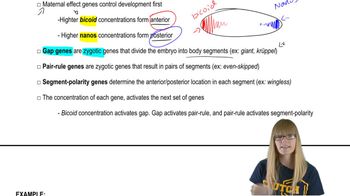One of the most interesting aspects of early development is the remodeling of the cell cycle from rapid cell divisions, apparently lacking G1 and G2 phases, to slower cell cycles with measurable G1 and G2 phases and checkpoints. During this remodeling, maternal mRNAs that specify cyclins are deadenylated, and zygotic genes are activated to produce cyclins. Audic et al. [(2001). Mol. and Cell. Biol. 21:1662–1671] suggest that deadenylation requires transcription of zygotic genes. Present a diagram that captures the significant features of these findings.
Table of contents
- 1. Introduction to Genetics51m
- 2. Mendel's Laws of Inheritance3h 37m
- 3. Extensions to Mendelian Inheritance2h 41m
- 4. Genetic Mapping and Linkage2h 28m
- 5. Genetics of Bacteria and Viruses1h 21m
- 6. Chromosomal Variation1h 48m
- 7. DNA and Chromosome Structure56m
- 8. DNA Replication1h 10m
- 9. Mitosis and Meiosis1h 34m
- 10. Transcription1h 0m
- 11. Translation58m
- 12. Gene Regulation in Prokaryotes1h 19m
- 13. Gene Regulation in Eukaryotes44m
- 14. Genetic Control of Development44m
- 15. Genomes and Genomics1h 50m
- 16. Transposable Elements47m
- 17. Mutation, Repair, and Recombination1h 6m
- 18. Molecular Genetic Tools19m
- 19. Cancer Genetics29m
- 20. Quantitative Genetics1h 26m
- 21. Population Genetics50m
- 22. Evolutionary Genetics29m
14. Genetic Control of Development
Developmental Patterning Genes
Problem 19b
Textbook Question
The apterous gene in Drosophila encodes a protein required for wing patterning and growth. It is also known to function in nerve development, fertility, and viability. When human and mouse genes whose protein products closely resemble apterous were used to generate transgenic Drosophila [Rincon-Limas et al. (1999). Proc. Nat. Acad. Sci. (USA) 96:2165–2170], the apterous mutant phenotype was rescued. In addition, the whole-body expression patterns in the transgenic Drosophila were similar to normal apterous.
What do these results indicate about the molecular nature of development?
 Verified step by step guidance
Verified step by step guidance1
Understand the context: The apterous gene in Drosophila is essential for wing patterning, nerve development, fertility, and viability, indicating it has multiple developmental roles.
Recognize that the experiment involved introducing human and mouse genes, which encode proteins similar to Drosophila apterous, into mutant flies lacking functional apterous.
Note that the mutant phenotype was rescued by these transgenic genes, meaning the human and mouse proteins could substitute for the Drosophila protein's function.
Interpret that the similar whole-body expression patterns of the transgenic genes compared to normal apterous suggest conservation not only in protein function but also in gene regulation across species.
Conclude that these results indicate a high degree of evolutionary conservation in the molecular mechanisms controlling development, implying that key developmental genes and their regulatory networks are preserved across diverse organisms.
 Verified video answer for a similar problem:
Verified video answer for a similar problem:This video solution was recommended by our tutors as helpful for the problem above
Video duration:
2mPlay a video:
Was this helpful?
Key Concepts
Here are the essential concepts you must grasp in order to answer the question correctly.
Gene Conservation Across Species
Gene conservation refers to the preservation of gene sequences and functions across different species through evolution. The ability of human and mouse genes to rescue the Drosophila apterous mutant phenotype demonstrates that key developmental genes are conserved, indicating similar molecular mechanisms govern development in diverse organisms.
Recommended video:
Guided course

Segmentation Genes
Functional Homology of Proteins
Functional homology means that proteins from different species can perform similar biological roles due to structural and sequence similarities. The rescue of the mutant phenotype by human and mouse apterous-like genes shows that these proteins share functional domains critical for wing patterning and other developmental processes.
Recommended video:
Guided course

Proteins
Molecular Basis of Developmental Processes
Developmental processes are controlled by specific genes encoding proteins that regulate growth, patterning, and differentiation. The experiment highlights that molecular pathways involving apterous are fundamental and conserved, emphasizing that development relies on precise gene expression and protein function across species.
Recommended video:
Guided course

mRNA Processing
Related Videos
Related Practice
Textbook Question
386
views


